This article covers how the editorial staff for 2 scientific journals promote their published articles on social media and beyond. Covered highlights include social media promotion, including Facebook, Instagram, X, and LinkedIn, as well as podcasts and press releases.
JAVMA and AJVR
The mission of the American Veterinary Medical Association® (AVMA) is to “lead the profession by advocating for our members, and advancing the science and practice of veterinary medicine to improve animal and human health.”
The AVMA has over 105,000 members and has 2 veterinary medical scientific publications. The Journal of the American Veterinary Medical Association® (JAVMA) is a hybrid, monthly, peer-reviewed journal. Manuscripts dealing with any subject germane to the practice of veterinary medicine are published in JAVMA. The journal is a member benefit that AVMA members receive in print, and it is also available online. The American Journal of Veterinary Research® (AJVR) is a gold open access, monthly, peer-reviewed journal. Reports of original research and review articles in the general area of veterinary medical research are published in AJVR.
In addition to traditional print and online publication of articles, social media can be a powerful platform for knowledge dissemination in scholarly publishing. An engaging presence on X (formerly Twitter) for scholarly journals has been linked to increased citations, which are important for a journal’s impact.1–6 Scholarly publishing teams have begun adding social media editors to promote their published articles, engage readers, and help boost their impact factor.1,5 In February of 2022, the first Social Media Editor was hired for JAVMA and AJVR. To the AVMA editorial team’s knowledge, JAVMA and AJVR are the only veterinary journals to have a dedicated Social Media Editor.
Article Promotion Methods
The Publications Division was able to create and implement its strategy through establishing this Social Media Editor position. The strategy included promoting authors’ work through social media, the Veterinary Vertex® podcast, and press releases to increase the online attention and reach for JAVMA and AJVR. The editorial team began capturing and analyzing online attention metrics using Meta Business Suite for Facebook and Instagram, Hootsuite for X and LinkedIn, and Altmetric for Facebook, X, news, policies, patents, blogs, and Reddit. Through these efforts, JAVMA’s online article attention has increased by over tenfold in less than 2 years.
Anatomy of a Social Media Post
The AVMA’s Marketing and Communications (Marcom) team created a template used for social media posts. The template is distinct from the association’s social media posts to convey editorial independence. The main emphasis of a post is the clinical relevance of an article (Figure 1). The LinkedIn posts appear very similar to the Facebook posts since both platforms have double the character limit compared with X, which is limited to less than 280 characters. LinkedIn will make a custom shortened link based on the URL provided (Figure 2). With X, the biggest difference is the use of hashtags (Figure 3).
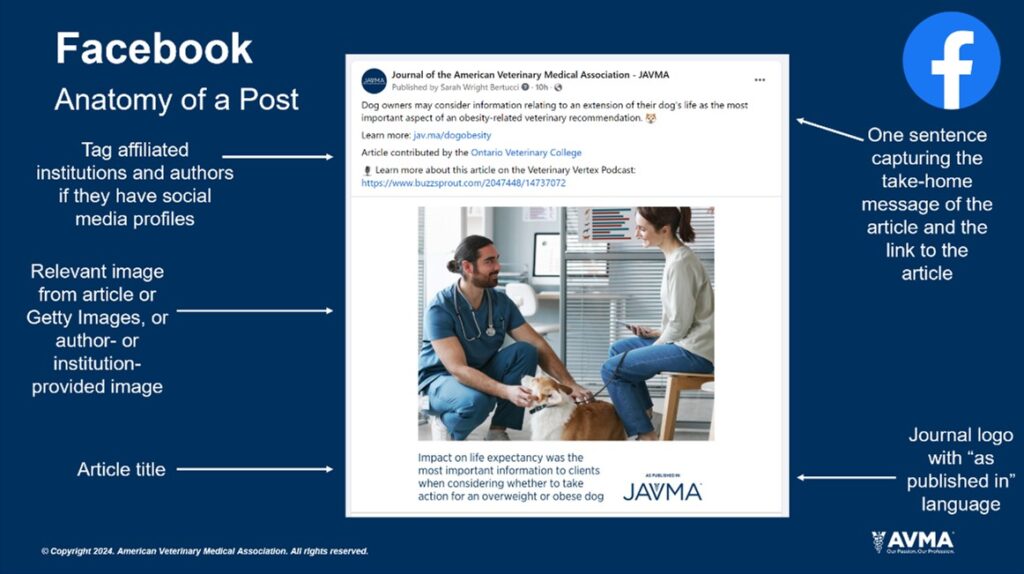
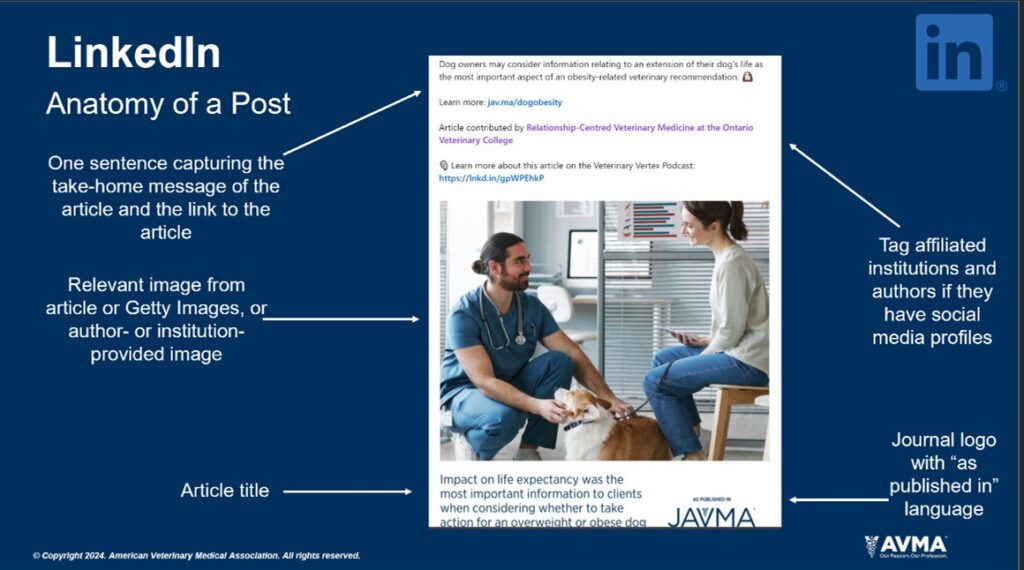
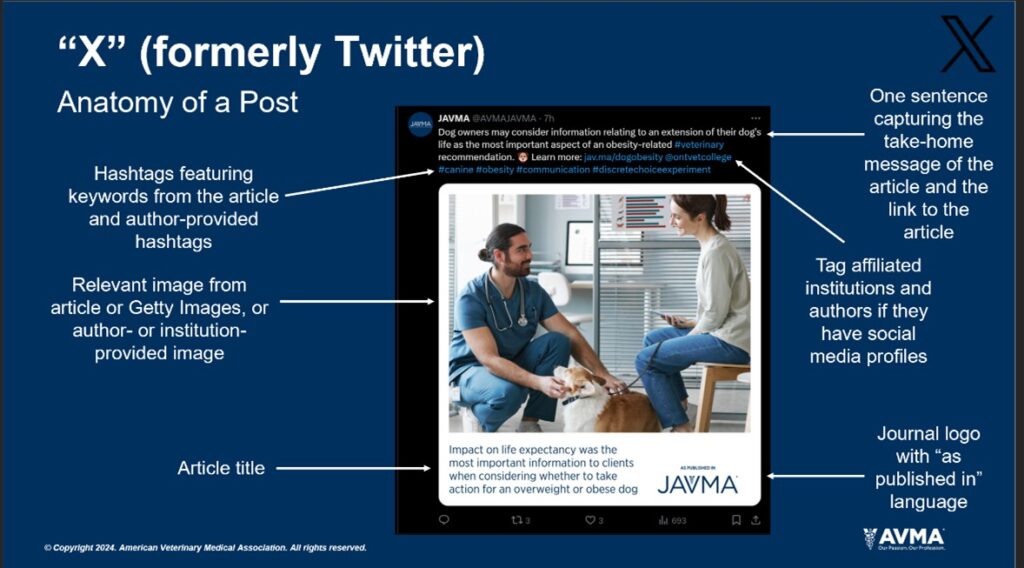
Instagram is unique in that users cannot click on active URLs. However, users can include up to 2 active URLs in the Instagram account’s bio. The Publications Division uses a website called Linktree for the URL in JAVMA’s and AJVR’s Instagram bios. Linktree houses several URLs at one time, and the expiration date for each URL can be customized. The JAVMA and AJVR team opts to house each article’s URL in Linktree for 48 hours before it expires to keep the content fresh and avoid clutter. Language such as “click on the link in our bio or type XYZ into your browser to read the article” (Figure 4) directs social media users to click the Linktree URL, which in turn leads them to the article.
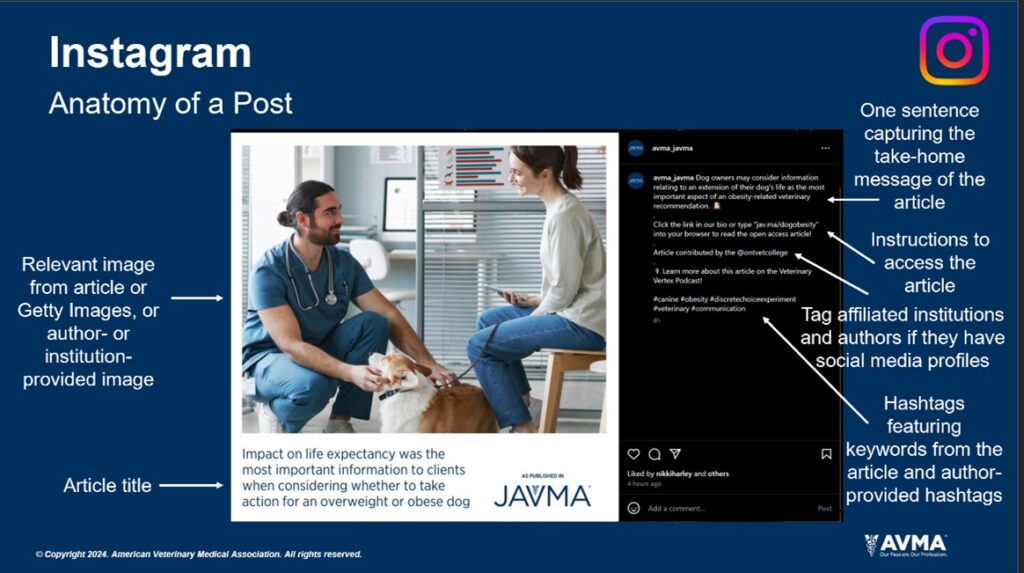
Overcoming Social Media Changes and Challenges
The social media space is constantly changing. In addition to more public transfers of ownership and branding, more nuanced differences with algorithms are constantly taking place. The editorial staff of JAVMA and AJVR subscribe to Social Media Today,7 a free e-letter that covers high-level and smaller changes on various social media platforms. Staying up to date with the latest social media trends can ensure that content stays contemporary and relatable to the target audience. The editorial team also follows competitor accounts for other journals in the veterinary space and has quarterly meetings with the AVMA social media team to stay apprised of what others are doing. The AVMA social media check-in meetings are especially helpful to plan cross-pollination of content, which can help visibility of the association.
Another challenge with managing social media accounts is that social never sleeps. Social media moderating is a 24/7/365 responsibility since users can comment and share content at all hours of the day. It can be nice to have social media moderating be a shared team activity to allow others time to “unplug.” This becomes challenging for small teams but is important, nonetheless.
As a veterinary medical journal, JAVMA often has difficulties finding appropriate stock images that are royalty-free, medically accurate, and on-brand for the association. It is also important to consider that anyone in the public can see the images posted on social media and to avoid anything too “graphic” since users can flag the posts as inappropriate, or the social platforms may blur the images for sensitive content.
Veterinary Vertex® Podcast
The editorial team launched the podcast Veterinary Vertex® in 2022. Editor-in-Chief Dr Lisa Fortier identifies clinically relevant articles upon submission that may be a good fit for the podcast. The authors are then contacted after acceptance with an invitation to be on the podcast. AVMA’s General Counsel copyrighted the name Veterinary Vertex® and generated new copyright forms for these episodes.
The podcast questions are scripted out, individualized for each article, and shared with the interviewees for their input prior to the episode being recorded. New 20- to 30-minute podcast episodes are published weekly. The podcast audio is edited using a free program called Audacity, and the edited audio is shared with the authors before being published online. Once the authors are happy with the audio, the podcast hosts share it with the author’s associated institutions for further promotion.
The podcast is hosted on Buzzsprout, where it is then disseminated to major podcast directories, such as Apple Podcasts and Spotify. Buzzsprout has Cohost AI generate titles, summaries, transcripts, and chapters, thus saving time for staff. Buzzsprout also provides episode-download metrics, such as top episodes, top apps, and number of downloads, which is helpful when working with advertising agencies.
After a year of publication, the podcast gained its first sponsorship with assistance from our advertising partners. The sponsor prerecords the audio promoting their product, and the editorial staff reviews the audio for accuracy. The advertisement is then placed at the beginning of the episode. Veterinary Vertex® has 103 published episodes and over 31,700 downloads and counting. It also has a global listenership (Figure 5) and was ranked no. 2 of the top 100 best veterinary podcasts by FeedSpot in 2024. The team hopes to increase the podcast’s reach in the future.
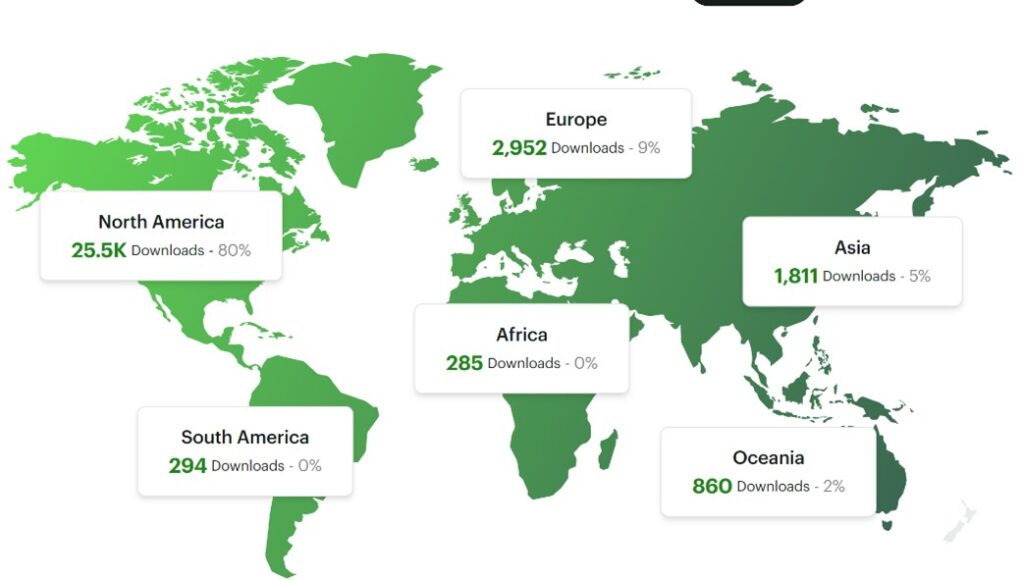
Press Releases
The AVMA’s Marcom team generates press releases for manuscripts that may be relevant for the public. The Editor-in-Chief identifies manuscripts at submission that may be of potential general interest to the public, and the Marcom team reads the article for suitability from a general news perspective. If the manuscript is accepted, the Marcom team will write a press release for the article and send it to various news agencies, such as PR Wire, Eurekalert, etc. The editorial team also shares the Altmetric link to the article with the authors so they can track the online attention it receives.
Putting It Together for Article Promotion Success
The editorial team collaborates with the authors, the AVMA journals’ production team, the Marcom team, and the authors’ institutions to have press releases, social media posts, and podcast episodes publish synchronously. Less than 2 years after developing and implementing an article promotion strategy, the JAVMA team increased the journal’s reach on Facebook by 1,000% (130,110 to 1,325,922 unique accounts), on Instagram by 8,679% (1,273 to 110,484 unique accounts), on X by 522% (110,000 to 684,362 unique accounts), and on LinkedIn by 11,563% (974 to 112,621 unique accounts). Social media content with the highest engagement included supplementary and technical tutorial videos posted as short reels, followed by case-based “What Is Your Diagnosis?” posts.
Social media, podcasts, and press releases have become dynamic tools in the AVMA’s promotion of authors and their work while increasing reader engagement. For the journals, use of social media also aids in recruitment of authors and reviewers. Staying apprised of social media trends, new platforms, and the development of artificial intelligence allows the AVMA editorial team to maximize the dissemination of the latest advancements in veterinary medicine.
Acknowledgements
Thank you to Victor Schultz and Cathlin Rosean for copyediting this article.
References and Links
- Aby ES, Rosenblatt R. Social media editors: tweeters with a cause. Liver Transpl. 2021;27:1380–1381. https://doi.org/10.1002/lt.26185.
- Demir HA, Dogan S. Correlation between academic citations in emergency medicine journals and Twitter mentions. Am J Emerg Med. 2022;58:33–38. https://doi.org/10.1016/j.ajem.2022.05.027.
- Erskine N, Hendricks S. The use of Twitter by medical journals: systematic review of the literature. J Med Internet Res. 2021;23:e26378. https://doi.org/10.2196/26378.
- Eysenbach G. Can tweets predict citations? Metrics of social impact based on Twitter and correlation with traditional metrics of scientific impact. J Med Internet Res. 2011;13:e123. https://doi.org/10.2196/jmir.2012.
- Lopez M, Chan TM, Thoma B, Arora VM, Trueger NS. The social media editor at medical journals: responsibilities, goals, barriers, and facilitators. Acad Med. 2019;94:701–707. https://doi.org/10.1097/ACM.0000000000002496.
- Pozdnyakov A, Abdullah P, Alabousi M, Alabousi A, Al-Ghita MK, Al-Ghetaa RK, Gappasov A, Patlas MN. Relationship between Twitter and radiology journal citations. Radiology. 2021;301:195–197. https://doi.org/10.1148/radiol.2021204655.
- https://www.socialmediatoday.com/
Sarah E Wright, DVM, CertAqV, (https://orcid.org/0000-0002-0097-5575) is Associate Editor, Journal of the American Veterinary Medical Association® and American Journal of Veterinary Research®.
Opinions expressed are those of the authors and do not necessarily reflect the opinions or policies of the Council of Science Editors or the Editorial Board of Science Editor.
